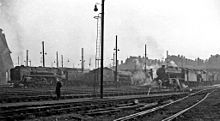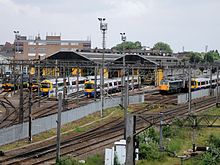Willesden Junction station
| Willesden Junction | |
|---|---|
 | |
| Location | Harlesden |
| Local authority | London Borough of Brent |
| Managed by | London Overground |
| Owner | Network Rail |
| Station code(s) | WIJ |
| DfT category | C2 |
| Number of platforms | 5 |
| Accessible | Yes[1] |
| Fare zone | 2 and 3 |
| London Underground annual entry and exit | |
| 2018 | |
| 2019 | |
| 2020 | |
| 2021 | |
| 2022 | |
| National Rail annual entry and exit | |
| 2006–07 | |
| 2007–08 | |
| 2008–09 | |
| 2009–10 | |
| 2010–11 | |
| 2011–12 | |
| 2012–13 | |
| – interchange | 2.319 million[7] |
| 2013–14 | |
| – interchange | 2.624 million[7] |
| 2014–15 | |
| – interchange | 2.712 million[7] |
| Key dates | |
| 1837 | Tracks laid (L&BR) |
| 1866 | Opened (LNWR) |
| 1915 | Started (DC Line & Bakerloo) |
| Other information | |
| External links | |
Willesden Junction station is a Network Rail station in Harlesden, north-west London, UK. It is served by both London Overground and the Bakerloo line of the London Underground.
History



The station developed on three contiguous sites:
- The West Coast Main Line (WCML) station was opened by the London & North Western Railway on 1 September 1866 to replace the London and Birmingham Railway's Willesden station of 1841 which was 0.5 miles (0.80 km) to the northwest. Passenger services ended in 1962 when the platforms were removed during electrification of the WCML to allow the curvature of the tracks to be eased. Later the bridges for the North London Line (NLL) were rebuilt.
- The High-Level station on the NLL was opened by the North London Railway in 1869 on a track crossing the WCML roughly at right angles.
- The 'Willesden New Station' or Low-Level station on the Watford DC Line was opened in 1910 to the north of the main line with two outer through platforms and two inner bay platforms at the London end. The bay platforms were originally long enough for four-coach Bakerloo trains when such trains ran outside peak times, but were shortened in the 1960s when a new toilet block was installed; in more recent times the platform buildings have been reconstructed and the bay length increased due to the addition of a fourth coach to class 378 trains, followed in October 2014 by a further westward excavation in preparation for the addition of a fifth coach to these trains.
The main-line platforms were numbered from the south side (including one or two on the Kensington route) followed by the high level platforms and then the DC line platforms which thus had the highest numbers. Later the surviving platforms were re-numbered.
Accidents and incidents
- On 5 December 1910, a passenger train was in a rear-end collision with another at the station. Three people were killed and more than 40 were injured.[8]
- On 6 October 1986 at 17.00 a class 313 train collided with the rear of a stationary Bakerloo Line train on the up line to the east of the station between the Scrubbs Lane overbridge and Kensal Green tunnel (the location was officially described as "Kensal Green"). 23 of 25 passengers were injured, all but one were discharged from hospital during the same evening.[9]
The station today
There are no platforms on the West Coast Main Line, which is separated from the low-level station by the approach road to Willesden Depot which lies immediately south-east of the station.
The high-level (HL) station consists of an island platform rebuilt in 1956, with faces as platforms 4 and 5, which are roughly at the level of Old Oak Lane to the west of the station, serving the NLL and the West London Line; some trains on the latter reverse in a central turnback siding on the NLL to the east of the station, this opened in 2011. Both platforms have been extended across the DC line to accommodate 4-coach class 378 trains. The HL station previously had a third platform on the eastern side which was used by services to/from Earls Court.[10] There is another turnback siding further east which was previously used; it was laid in the late 1990s to allow Royal Mail trains to reach the Royal Mail depot at Stonebridge Park.
The low-level station, at the level of the area to the south, is an Edwardian island platform, with outer faces as platforms 1 and 3 and northern bay platform bay as platform 2, the southern bay now has no track. In October 2014 the DC line was closed temporarily between Wembley Central and Queens Park reportedly by Network Rail (London Overground) to allow platform 2 to be extended further west as a through platform.[11] Most of the original and later platform buildings were demolished when platform 2 was extended in preparation for longer Class 378 trains and provision of a new footbridge and lift in 1999.
Platforms 1 and 3 are used by the Bakerloo line services, which began on 10 May 1915.[12] and London Overground services between Euston and Watford Junction. Until May 2008 north-bound Bakerloo line trains which were to reverse at Template:LUL stations depot (two stations further north) ran empty from Willesden Junction although the southbound service began at Stonebridge Park. This imbalance arose as there were no London Underground staff beyond Willesden Junction to oversee passenger detrainment, but this changed after London Underground took over the staffing of stations on the line, including Stonebridge Park, from Silverlink in November 2007,[13] and trains bound for Stonebridge Park depot now terminate at Stonebridge Park station.[14] Normally only the first and last NLL trains of the day, which start or terminate here, use the bay platform, though it is used for empty stock transfers between the depot and the North London and Gospel Oak to Barking lines.
The station signs on the platforms say, below the Overground roundel, "Alight for Harlesden town centre".
Motive power depot


The LNWR opened a large locomotive depot on a site on the south side of the main line to the west of the station, in 1873. This was enlarged in 1898. The London Midland and Scottish Railway opened an additional roundhouse on the site in 1929. Both buildings were demolished when the depot was closed in 1965 by British Railways and replaced by a Freightliner depot.[15] (The servicing of locomotives and multiple units was then undertaken by the present Willesden TMD on the other side of the line.)
The steam depot had the shed code 1A and was a major depot for predominantly freight locomotives used on the West Coast Main Line and for suburban passenger services from Euston.
Services

The typical off-peak London Underground service at Willesden Junction is six Bakerloo line trains per hour (tph) between Template:LUL stations and Template:LUL stations and three Bakerloo line trains per hour (tph) between Template:LUL stations and Template:LUL stations.
London Overground services are normally operated by Class 378 Capitalstar units. The typical off-peak North London Line, West London Line and Watford DC Line services at the station in trains per hour are:
- 3 northbound to Watford Junction.
- 3 southbound to Euston.[16]
- 4 westbound to Template:LUL stations.
- 6 eastbound to Template:LUL stations (4 from Richmond, 2 from Clapham Junction).
- 4 southbound to Clapham Junction.[17]
Southern Railway services travelling between Milton Keynes Central/Watford Junction and the South Croydon/East Croydon, and slow London Midland services travelling between London Euston and Tring, currently do not stop at this station, as there are currently no platforms provided on the lines which previously passed through the southernmost platforms of the main line station, and which now form the up and down Willesden relief lines. However, in the future there is a proposed plan for these services to stop here, which will involve building new platforms on the WCML.
Other Public Transport Connections
The station area is served by London Buses routes 18, 220, 228, 266, 487 and night route N18.
References
- ^ "Step free Tube Guide" (PDF). Transport for London. April 2021. Archived (PDF) from the original on 15 May 2021.
- ^ "Station Usage Data" (CSV). Usage Statistics for London Stations, 2018. Transport for London. 23 September 2020. Archived from the original on 14 January 2023. Retrieved 11 October 2023.
- ^ "Station Usage Data" (XLSX). Usage Statistics for London Stations, 2019. Transport for London. 23 September 2020. Archived from the original on 9 November 2020. Retrieved 9 November 2020.
- ^ "Station Usage Data" (XLSX). Usage Statistics for London Stations, 2020. Transport for London. 16 April 2021. Retrieved 1 January 2022.
- ^ "Station Usage Data" (XLSX). Usage Statistics for London Stations, 2021. Transport for London. 12 July 2022. Retrieved 7 September 2022.
- ^ "Station Usage Data" (XLSX). Usage Statistics for London Stations, 2022. Transport for London. 4 October 2023. Retrieved 10 October 2023.
- ^ a b c d e f g h i j k l "Estimates of station usage". Rail statistics. Office of Rail Regulation. Please note: Some methodology may vary year on year.
- ^ Earnshaw, Alan (1991). Trains in Trouble: Vol. 7. Penryn: Atlantic Books. p. 13. ISBN 0-906899-50-8.
- ^ Railways Archive - Report on the collision that occurred on 16th October 1986 at Kensal Green (pub. Department of Transport 1989)
- ^ Disused Stations - Willesden Junction
- ^ London Overground Capacity Improvement
- ^ "Bakerloo Line, Dates". Clive's Underground Line Guides. Retrieved 22 July 2008.
- ^ "Safety boost as London Underground takes full control of 14 Silverlink stations". Transport for London. 22 November 2007. Retrieved 28 January 2013.
- ^ "Bakerloo line changes benefit over 7,000 passengers". Transport for London. 18 July 2008. Retrieved 28 January 2013.
- ^ Griffiths, Roger; Smith, Paul (1999). The directory of British engine Sheds and Principal Locomotive Servicing Points: 1. Oxford: Oxford Publishing Co. p. 93. ISBN 0-86093-542-6.
- ^ Watford DC Line timetable from 22 May 2011.
- ^ North London Line timetable from 22 May 2011.
External links
- Train times and station information for Willesden Junction station from National Rail
- London Transport Museum Photographic Archive
- Willesden Junction, SubBrit stations project
- Winchester, Clarence, ed. (18 October 1935), "Willesden Junction", Railway Wonders of the World, pp. 1192–1194, description of the station in the 1930s
- Use dmy dates from February 2012
- Rail transport stations in London fare zone 2
- Rail transport stations in London fare zone 3
- DfT Category C2 stations
- Bakerloo line stations
- Tube stations in Brent
- Railway stations in Brent
- Former London and North Western Railway stations
- Railway stations opened in 1866
- Railway stations served by London Overground
- 1866 establishments in England
